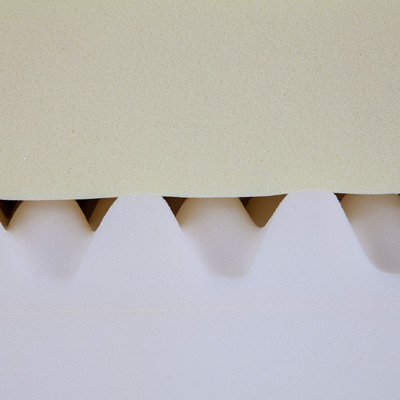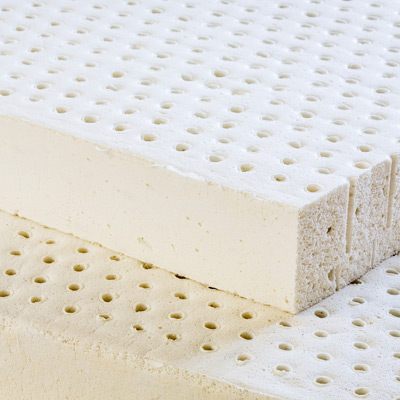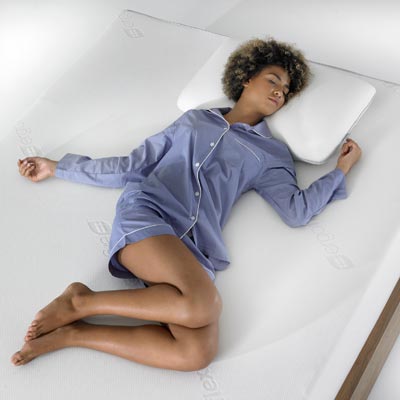What is the difference between Memory Foam and Latex?
29-09-2016

When it comes to mattresses, there is often a common misconception regarding latex and memory foam mattress types. Many people assume that latex and memory foam mattresses are the same thing, but in reality, these are actually very different products. From materials they are made of, to responsiveness and availability of each of these mattress types, there are several key differences between the two which are worth exploring. Read on to learn more about the difference between memory foam and latex!
 The Differences between Memory Foam and Latex:
The Differences between Memory Foam and Latex:
Perhaps the most outstanding difference between latex and memory foam is the ingredients used in the production of these materials.
To start with, memory foam is a type of technologically advanced polyurethane (PU) foam with added materials that increase its density and viscosity; and is often referred to as visco-elastic PU foam.
A true visco-elastic memory foam is made of billions of spherical-shaped open cells, which are designed to respond to pressure points as well as body temperature. It softens in reaction to body heat causing it to conform to your specific body shape in just a few minutes; whilst the open cells shift their form under the pressure of your body weight allowing the foam to contour to the body and provide support where it's needed the most.
A memory foam mattress can consist of a memory foam comfort layer on top of a regular foam base, or it can have memory foam as the core support layer. In addition, memory foam mattresses have an open cell structure that allows air to freely circulate through the material.
On the other hand, latex foam comes in three different types which are: Natural, Latex, Synthetic (Man Made) Latex, and Blended (Mixed) Latex.
• The first type - natural latex foam - is made from processed tree sap, which is a milky white fluid extracted from the Hevea Brasiliensis tree, commonly known as the rubber tree. This type of latex foam is very supportive and has a springy feel to it. However, it is quite rare to find true, 100% natural latex mattresses, since compared to other types they are more expensive due to the relatively high cost of manufacturing and extraction.
• The second type – synthetic latex foam – is a synthetically produced compound that is made of petroleum-based oils and chemical additives. It’s designed to mimic the properties of latex; but compared to natural latex foam, synthetic latex typically has a duller, less springy feel. There are different types of synthetic latex in existence, but the most common type used in the manufacture of synthetic latex foam is SBR (styrene-butadiene rubber). Synthetic latex mattresses are widely available and much cheaper than the natural alternative.
• As the name suggests, the third type - blended latex foam - is literally a blend of synthetic and natural latex; which is normally 20% natural and 80% synthetic. Sometimes the mixture could also be a 50% equal mix, but in most cases producers prefer to use synthetic latex as the major content with only a small amount of natural latex, so as to cut the cost of production. It is basically a cheaper alternative for producing natural latex foam. Blended latex mattresses are quite common and relatively cheap; and they’re designed to provide a good balance of the two aforementioned types in terms of value for money, durability and build quality.
 Overall, there are three main categories of latex mattresses irrespective of whether the mattress is made with 100% natural latex, blended latex or synthetic latex. These are:
Overall, there are three main categories of latex mattresses irrespective of whether the mattress is made with 100% natural latex, blended latex or synthetic latex. These are:
• The All-Latex category whereby the mattresses are made of latex from top to bottom;
• The Latex-Over-Foam category that consists of mattresses with a latex comfort layer over a thicker foam base, and;
• The Foam-Over-Latex category
There are also two manufacturing processes used to make latex, the Dunlop and Talalay method. The traditional Dunlop method has been used in latex manufacture since 1929. The thick rubber sap is whipped into a froth in a centrifuge, poured into a mold, covered, and steam baked. The Talalay process adds two extra steps. After the latex is poured, the mold is sealed and the process is continued in a vacuum chamber. The mold is then flash-frozen before it's baked. Dunlop is denser, which makes it a bit firmer overall. Talalay is a good choice if you like a softer feel.
What Are The Differences between Memory Foam and Latex?
Apart from what each mattress type is made of, there are other significant differences between latex and memory foam, and more so in terms of performance, quality and affordability. These include:
• How They Feel: Everyone has different comfort preferences, which makes rating how firm or soft a specific mattress type feels to each of us a very subjective analysis. However, in general, memory foam mattresses tend to have cloud-like, floating sensation and feel; whilst latex mattress types have a more solid feel with a somewhat rubbery or "springy" characteristic. Additionally, since memory foam is temperature sensitive unlike latex, it tends to feel softer when in contact with the sleeper’s body or in warmer temperatures; and firmer in cool temperatures.
• Pressure Relief: Though granted that pressure relief is a strength of both latex and memory foam mattress types, in our opinion the latter edges out the former. Compared to latex, memory foam (especially higher density) moulds itself much more efficiently to the contours of your natural body shape leading to more equal distribution of your weight on the mattress. This in turn helps to support the major pressure points over the sleeper’s body, providing one with a somewhat better pressure-point relief than latex. Most memory foam mattress owners report a significant relief from pressure points especially to their shoulders and hips, giving them a more restful and comfortable sleep.
 For many years now, visco-elastic memory foam mattresses have been used by health authorities and many hospitals around the world, due to their great ability to significantly reduce pressure points and increase the comfort of people spending long, immobile periods of time on hospital beds.
For many years now, visco-elastic memory foam mattresses have been used by health authorities and many hospitals around the world, due to their great ability to significantly reduce pressure points and increase the comfort of people spending long, immobile periods of time on hospital beds.
• (Back) Pain Relief: As is the case with pressure relief, pain relief is another common strength of both mattress types but memory foam also edges out latex in this matter. A memory foam mattress is the best mattress you can buy to help with back pain. This is probably because memory foam is designed to cradle your body while you sleep, making it the perfect solution for those night-time aches and pains including back pain, neck pain and shoulder pain. In fact, unlike many latex brands, most memory foam mattresses like our very own Ergoflex™ memory foam mattress are not only designed with this type of support in mind, but also as a priority.
• Responsive: In the world of mattresses, the term “responsive" refers to how fast a mattress type is able to get back to its original shape after being compressed. Compared to memory foam, latex is faster in this particular aspect. Latex mattress types have the capability to quickly regain their original shape (almost instantly), while their memory foam counterparts can take a couple of seconds or even minutes to achieve this. One can say that memory foam has greater "memory"!
• Motion Isolation or Partner Disturbance: In general terms, “motion isolation” alludes to how well a mattress is capable of keeping motion on your bed localised. Therefore, if a mattress has good motion isolation this simply means that it is able to efficiently absorb one person’s movement on the bed, and hence preventing it from travelling to another sleeper on the same bed and possibly disturbing him or her. On this issue, memory foam universally does well when compared to latex. Most memory foam mattresses are designed to eliminate the problem of being constantly woken up during night-time when your partner is an “active” sleeper. They are often considered as couple friendly as they offer zero partner disturbance.
• Body Heat: Excess heat at night is one of the most commonly made complaints regarding some latex and some memory foam mattresses. This is because, being temperature sensitive they can act as a heat trap for your body heat while sleeping; and as this builds up, it creates an uncomfortably warm sleeping surface which can hamper your sleep. However, over the years, several improved models of latex and memory foam have been introduced to the market, which make use of various airflow technologies designed to counteract this problem.
The Ergoflex™ Visco-Elastic memory foam mattress that comes with an integrated "Cool-Sleep" airflow system layer, whose purpose is to negate heat retention. This unique invention makes it possible for air to flow naturally through the bodies of these mattresses, thus preventing overheating and keeping the beddings temperate as you sleep. Unfortunately, many lesser latex and memory foam mattress alternatives normally avoid this essential layer.
• Durability: When it comes to durability, both latex and memory foam mattresses have a long lifespan with everyday use. However, after prolonged use, latex mattresses tend to become excessively soft and they can also develop body indentations or impressions fairly early where one sleeps, thus leading to poor support and comfort. On the other hand, high density memory foam mattresses should provide you with optimum support and comfort equally as long as a latex mattress if not longer. After all, a memory foam mattress returns to its original state each and every time you get up off the mattress.
• Variations in Quality: As with most products there are definitive high and low ends of the market when it comes to both memory foam and latex mattresses, which are reflected in price, performance and longevity. With memory foam mattresses the differences between mattresses tend to be based on foam density, the layered composition that makes up the mattress, and the depth of the layers themselves. In some cases, some mattresses that are marketed as ‘memory foam’ don’t contain any actual memory foam at all. When it comes to latex mattresses, production method and layer depth are the two main points of difference between high-end and low-end options. A relatively low cost latex mattress is more than likely to contain little more than a thin layer (sometimes around 2cm) of low quality latex, yet it can still be marketed as a ‘latex mattress’ in much the same way as a premium quality mattress that contains optimum levels of the best quality, expensively manufactured latex.
 Generally, whether you’re looking to buy a memory foam or a latex mattress, the more detailed information a retailer provides on the mattress properties will indicate a better quality product. Be wary of ‘too good to be true’ prices and vague, unsubstantiated claims. The phrase ‘false economy’ is never more appropriate than when it comes to mattresses – if you buy cheaply you’ll not only get a poor quality sleep, you’ll be shelling out for another mattress again far sooner than if you’d bought quality first time around.
Generally, whether you’re looking to buy a memory foam or a latex mattress, the more detailed information a retailer provides on the mattress properties will indicate a better quality product. Be wary of ‘too good to be true’ prices and vague, unsubstantiated claims. The phrase ‘false economy’ is never more appropriate than when it comes to mattresses – if you buy cheaply you’ll not only get a poor quality sleep, you’ll be shelling out for another mattress again far sooner than if you’d bought quality first time around.
• Price and Affordability: In terms of budget, latex mattresses are relatively much more expensive compared to memory foam mattresses. Due to high production costs for latex foam the high price is usually relayed back to the consumers. Overall, memory foam mattresses are typically at least ten percent cheaper than latex mattresses of equal thickness. Therefore, for someone on a budget, a memory foam mattress makes an excellent choice without compromising on quality and durability.
Final Thoughts:
All in all, latex and memory foam are both undeniably great materials for making comfortable and resilient mattresses. Naturally of course we would recommend memory foam. The Ergoflex™ memory foam mattress is skilfully engineered and designed to provide you with excellent comfort and support; and thereby giving you optimum sleeping experience every single night.
Here’s our own comprehensive quick guide to memory foam and what you should look for when buying a memory foam mattress including density rating, ILD rating and firmness. These three major indicators that will influence how the mattress will perform and the feeling you will experience.
Further Reading
If you enjoyed this article you will find the below of interest:
How do I know if I need a new mattress?
The ultimate sleep improvement checklist
Introducing the all-new Ergoflex 5G Memory Foam Mattress
